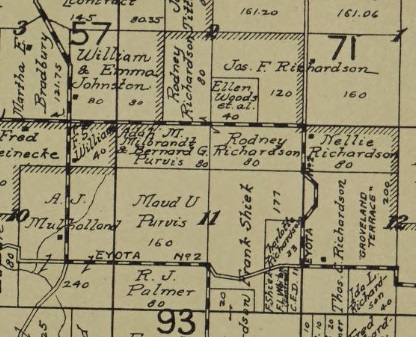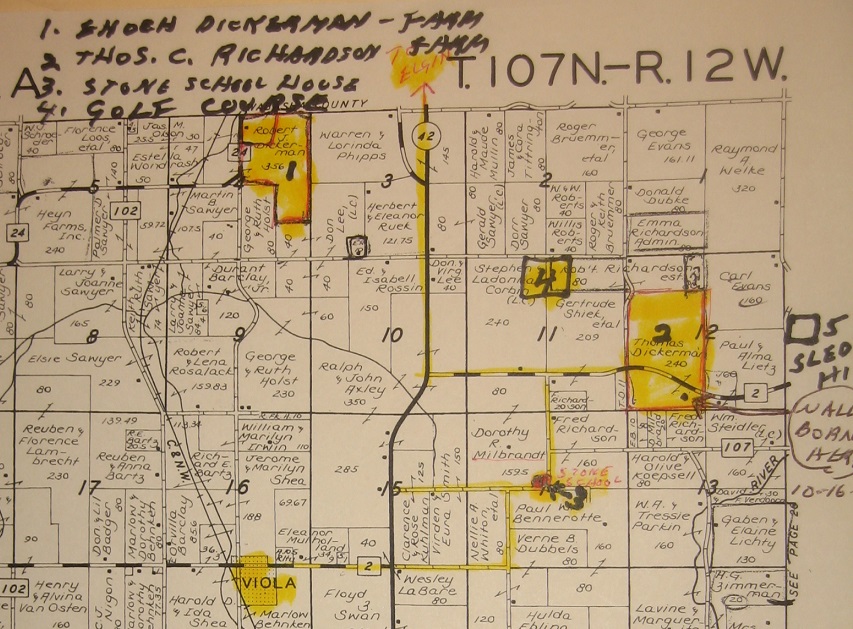No abandoned golf course disappears without a trace.
From a physical standpoint, an out-of-commission golf course can be left to revert to nature, almost all signs of its existence dissolving within a decade or less. Or it can be bulldozed off the face of the earth, the starkest example in Minnesota being the old Rich Acres course in Bloomington giving way to Runway 17/35 of Minneapolis-St. Paul International Airport in the spring of 2000.
But in all cases, even if it’s only a wisp in someone’s memory or yellowed scorecard or a two-sentence entry in a newspaper archive, some fragment of the golf course carries on.
There are significant examples in Minnesota of lost courses’ legacies, such as Minneapolis’ Bryn Mawr Golf Club, whose two iterations spawned two classics: The Minikahda Club (1898) and Interlachen Country Club (1910). There was the little, big, remarkable course at Ferndale in Wayzata, where the six golf holes were but a sidebar to the patricians who promoted the game almost 120 years ago. Then there are mostly forgotten lost courses that honestly left no palpable legacies, such as the recently rediscovered Madelia Golf Club in southwestern Minnesota.
And mostly, there are in-betweens.
One such tweener was Elgin Golf Club, situated three miles south of the Goodhue County city of Elgin but lying just inside of northeastern Olmsted County. The Elgin golf course is inextricably linked to the Richardson families of Elgin and Plainview and had until recently been considered by the family to be “a neighborhood thing … maybe five or six holes carved out of a pasture,” said Scott Richardson of Northfield.
That doesn’t really do justice to Elgin Golf Club — either the golf course or its extended if modest legacy.
Elgin Golf Club was founded in 1931. The Minneapolis Tribune offered one paragraph’s worth of statewide introduction to the grounds with this blurb on April 26, 1931: “Elgin, Minn., April 25 –Six holes on the new golf course south of here have been opened for play and the remaining three holes have been seeded and will be available later in the season.”
The Tribune presumably had summarized a story that ran in the local newspaper, the Elgin Monitor, on April 17, 1931.
“New Golf Course Opened This Week,” read the headline, followed by:
“Altho the new golf course which Bernard Purves and Rodney Richardson and building on their farms three miles south of Elgin, is, of course, far from completion, these young men have done an immense amount of work on it so far this spring and opened six holes for play this week. As a part of the course is on new seeding, the last three holes will not be ready for play until about the middle of June.
“Local fans have been out trying the new course and pronounce the new greens to be very good. …
“Each week shows some change in this transformation of a pasture into a golf course. This week the appearance of some fine new benches at all of the tees added its bit to the scene. These were presented to the club by various business men of the village. A few more trees have been transplanted this spring and these will add much in the appearance.
“The course is conveniently located within a ten minute drive from town. It is 2 1/2 miles south of Elgin on highway No. 42 and turning east at the Johnston corner another half mile brings one to the course which is on the south side of the road.”
Richardson and Purves — alternately spelled Purvis in newspapers and other documents; I will go with “Purvis” for the sake of clarity — were well-known names in early-1900s Elgin. George Purvis and R. Richardson were among the incorporators of Farmers and Merchants State Bank of Elgin in 1914. Thomas Richardson was the bank’s vice president in 1918. H.G. Richardson operated a general store and elevator in Elgin in the late 1800s.
George Purvis was the father of Bernard Purvis, the golf course co-founder. George Purvis died in 1926; Bernard Purvis and M. Milbrandt were listed as owners as part of the golf course property in a 1928 Olmsted County plat map. Richardsons, meanwhile, were everywhere in sight. One Richardson or another was listed as the owner of no fewer than nine plots within about a half-mile of the golf course in 1928, with Rodney Richardson the owner of the golf course land adjacent to that of Purvis and Milbrandt.


Enough geneaology. Back to golf.
By late June 1931, a seventh green at Elgin Golf Club had been completed. On July 17, the Elgin Monitor reported on the first tournament held at Elgin Golf Club. It featured 28 players and was a “spirited contest” whose intentions were to “accustom the members to tournament play,” the newspaper reported.
“No brilliant scores were turned in by anyone,” the story read. Robert Holton was low man, with a 43-43–86, while Will Haas’ game needed some fine-tuning, as he anchored the field with a 67-72–139. The area’s next tournament was to be the next Sunday against the Whitewater Golf Club of St. Charles (the Whitewater Valley Golf Course in Whitewater State Park, featured and pictured on the cover of “Fore! Gone.”, was permanently flooded out in 1974).
The Elgin course reopened in 1932, albeit with changes in store. The Monitor reported on April 15 that Rodney Richardson would be taking charge of the course and that he “expects to eliminate the dog-leg holes of the course and provide for two 500-yard holes.” A number of residents of nearby Plainview were expressing interest in joining the club, the newspaper said.
In early June, a tournament had been scheduled for players from Elgin and Plainview, and Richardson’s proposed changes had been executed, the Monitor reported. In mid-June, Elgin defeated Plainview 19-18 in a tournament at Elgin GC; Charlie Duerre of Plainview was medalist with an 83 and was afforded the company of three new golf balls as payoff.
The Monitor reported on June 17, 1932, that more tournaments were scheduled to be played at Elgin Golf Club. Maybe that happened. However, I did not find any subsequent mention of Elgin Golf Club in the Monitor. By 1934, one of the newspaper’s few stories on local golf reported on a tournament at Soldiers Field in Rochester and that “several Elgin players expect to enter the home tournament to be played at Whitewater Park next Sunday.”
Goodbye, Elgin Golf Club. But wait. What about that reference to legacies?
Elgin Golf Club’s legacy lived on in the form of Wallace Richardson, grand-nephew of Rodney Richardson. Wallace Richardson was entering his teen years when Elgin GC took shape a few hundred yards west of his home. Whether it was the new golf course or some other that hooked him on the game, golf resonated with young Wallace Richardson. He became an adept player, participating in the 1937 state junior tournament, and an avid supporter of the game.
Wallace Richardson moved to Plainview in 1947 and lived there until his death on Sept. 3, 2017. He was an insurance agent and banker and, as noted in his Rochester Post-Bulletin obituary, “served on numerous community projects, including … the construction of the Piper Hills Golf Course.”
Piper Hills, on the south side of Plainview, was built in 1968 by Rochester professional Ray Keller and opened for general play in 1969. It was briefly known as Windcrest in the early 1970s but in any event has operated for nearly a half-century, perhaps in some small way as a tribute to Wallace Richardson and his long-ago connection to the lost Elgin Golf Club.
Latest posts by Joe Bissen (see all)
- Island courses: Photo gallery - February 24, 2024
- Island outposts: Coney Isle and Circle Lake - February 24, 2024
- Lost courses, or just my imagination? - February 7, 2022

Joe,
I was down to Viola Gopher Count in June, and of course the family stories started flowing. When I got home I revisited your account of the Elgin Golf Course, and have two corrections to the record. First, Elgin is in Wabasha County, not Goodhue. Second, my Dad Wally Richardson’s relation to Rodney Richardson is cousin once removed, not a grand nephew. There are several Rodney Richardsons floating around the family tree. My Dad’s grand uncle Rodney Richardson died in 1919. I believe the Rodney who invested in the golf course was Henry Clay Richardson’s son Rodney, who was probably named for his uncle Rodney. H.C.’s son was born in 1895 and would have been in his early 30s when the golf course was being built. What I can tell from land ownership supports my theory.
I also have a question for you: Are you able to access Elgin Monitor newspapers online?
Thank you for the corrections, Scott. They have been made in my post. I should have known better on the county designation. I’m afraid I don’t have access to those newspapers online, but I spent a fair amount of time reading them at the Minnesota History Center. I’m afraid I’m not inclined to go back and look for more, as I spent a decade researching these places – and had a blast doing so – but have largely taken up other pursuits now. Cheers.